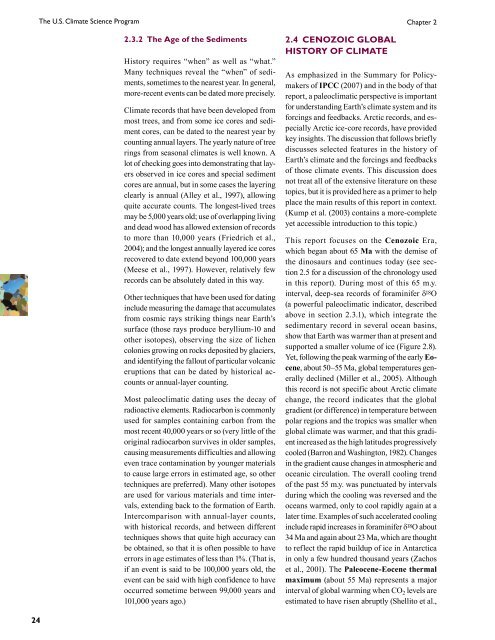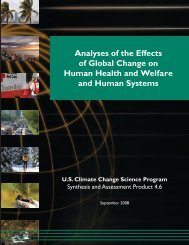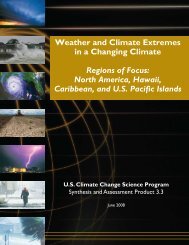Past Climate Variability and Change in the Arctic and at High Latitudes
Past Climate Variability and Change in the Arctic and at High Latitudes
Past Climate Variability and Change in the Arctic and at High Latitudes
You also want an ePaper? Increase the reach of your titles
YUMPU automatically turns print PDFs into web optimized ePapers that Google loves.
24<br />
The U.S. <strong>Clim<strong>at</strong>e</strong> Science Program Chapter 2<br />
2.3.2 The Age of <strong>the</strong> Sediments<br />
History requires “when” as well as “wh<strong>at</strong>.”<br />
Many techniques reveal <strong>the</strong> “when” of sediments,<br />
sometimes to <strong>the</strong> nearest year. In general,<br />
more-recent events can be d<strong>at</strong>ed more precisely.<br />
<strong>Clim<strong>at</strong>e</strong> records th<strong>at</strong> have been developed from<br />
most trees, <strong>and</strong> from some ice cores <strong>and</strong> sediment<br />
cores, can be d<strong>at</strong>ed to <strong>the</strong> nearest year by<br />
count<strong>in</strong>g annual layers. The yearly n<strong>at</strong>ure of tree<br />
r<strong>in</strong>gs from seasonal clim<strong>at</strong>es is well known. A<br />
lot of check<strong>in</strong>g goes <strong>in</strong>to demonstr<strong>at</strong><strong>in</strong>g th<strong>at</strong> layers<br />
observed <strong>in</strong> ice cores <strong>and</strong> special sediment<br />
cores are annual, but <strong>in</strong> some cases <strong>the</strong> layer<strong>in</strong>g<br />
clearly is annual (Alley et al., 1997), allow<strong>in</strong>g<br />
quite accur<strong>at</strong>e counts. The longest-lived trees<br />
may be 5,000 years old; use of overlapp<strong>in</strong>g liv<strong>in</strong>g<br />
<strong>and</strong> dead wood has allowed extension of records<br />
to more than 10,000 years (Friedrich et al.,<br />
2004); <strong>and</strong> <strong>the</strong> longest annually layered ice cores<br />
recovered to d<strong>at</strong>e extend beyond 100,000 years<br />
(Meese et al., 1997). However, rel<strong>at</strong>ively few<br />
records can be absolutely d<strong>at</strong>ed <strong>in</strong> this way.<br />
O<strong>the</strong>r techniques th<strong>at</strong> have been used for d<strong>at</strong><strong>in</strong>g<br />
<strong>in</strong>clude measur<strong>in</strong>g <strong>the</strong> damage th<strong>at</strong> accumul<strong>at</strong>es<br />
from cosmic rays strik<strong>in</strong>g th<strong>in</strong>gs near Earth’s<br />
surface (those rays produce beryllium-10 <strong>and</strong><br />
o<strong>the</strong>r isotopes), observ<strong>in</strong>g <strong>the</strong> size of lichen<br />
colonies grow<strong>in</strong>g on rocks deposited by glaciers,<br />
<strong>and</strong> identify<strong>in</strong>g <strong>the</strong> fallout of particular volcanic<br />
eruptions th<strong>at</strong> can be d<strong>at</strong>ed by historical accounts<br />
or annual-layer count<strong>in</strong>g.<br />
Most paleoclim<strong>at</strong>ic d<strong>at</strong><strong>in</strong>g uses <strong>the</strong> decay of<br />
radioactive elements. Radiocarbon is commonly<br />
used for samples conta<strong>in</strong><strong>in</strong>g carbon from <strong>the</strong><br />
most recent 40,000 years or so (very little of <strong>the</strong><br />
orig<strong>in</strong>al radiocarbon survives <strong>in</strong> older samples,<br />
caus<strong>in</strong>g measurements difficulties <strong>and</strong> allow<strong>in</strong>g<br />
even trace contam<strong>in</strong><strong>at</strong>ion by younger m<strong>at</strong>erials<br />
to cause large errors <strong>in</strong> estim<strong>at</strong>ed age, so o<strong>the</strong>r<br />
techniques are preferred). Many o<strong>the</strong>r isotopes<br />
are used for various m<strong>at</strong>erials <strong>and</strong> time <strong>in</strong>tervals,<br />
extend<strong>in</strong>g back to <strong>the</strong> form<strong>at</strong>ion of Earth.<br />
Intercomparison with annual-layer counts,<br />
with historical records, <strong>and</strong> between different<br />
techniques shows th<strong>at</strong> quite high accuracy can<br />
be obta<strong>in</strong>ed, so th<strong>at</strong> it is often possible to have<br />
errors <strong>in</strong> age estim<strong>at</strong>es of less than 1%. (Th<strong>at</strong> is,<br />
if an event is said to be 100,000 years old, <strong>the</strong><br />
event can be said with high confidence to have<br />
occurred sometime between 99,000 years <strong>and</strong><br />
101,000 years ago.)<br />
2.4 CENOZOIC GLOBAL<br />
HISTORY OF CLIMATE<br />
As emphasized <strong>in</strong> <strong>the</strong> Summary for Policymakers<br />
of IPCC (2007) <strong>and</strong> <strong>in</strong> <strong>the</strong> body of th<strong>at</strong><br />
report, a paleoclim<strong>at</strong>ic perspective is important<br />
for underst<strong>and</strong><strong>in</strong>g Earth’s clim<strong>at</strong>e system <strong>and</strong> its<br />
forc<strong>in</strong>gs <strong>and</strong> feedbacks. <strong>Arctic</strong> records, <strong>and</strong> especially<br />
<strong>Arctic</strong> ice-core records, have provided<br />
key <strong>in</strong>sights. The discussion th<strong>at</strong> follows briefly<br />
discusses selected fe<strong>at</strong>ures <strong>in</strong> <strong>the</strong> history of<br />
Earth’s clim<strong>at</strong>e <strong>and</strong> <strong>the</strong> forc<strong>in</strong>gs <strong>and</strong> feedbacks<br />
of those clim<strong>at</strong>e events. This discussion does<br />
not tre<strong>at</strong> all of <strong>the</strong> extensive liter<strong>at</strong>ure on <strong>the</strong>se<br />
topics, but it is provided here as a primer to help<br />
place <strong>the</strong> ma<strong>in</strong> results of this report <strong>in</strong> context.<br />
(Kump et al. (2003) conta<strong>in</strong>s a more-complete<br />
yet accessible <strong>in</strong>troduction to this topic.)<br />
This report focuses on <strong>the</strong> Cenozoic Era,<br />
which began about 65 Ma with <strong>the</strong> demise of<br />
<strong>the</strong> d<strong>in</strong>osaurs <strong>and</strong> cont<strong>in</strong>ues today (see section<br />
2.5 for a discussion of <strong>the</strong> chronology used<br />
<strong>in</strong> this report). Dur<strong>in</strong>g most of this 65 m.y.<br />
<strong>in</strong>terval, deep-sea records of foram<strong>in</strong>ifer δ 18O<br />
(a powerful paleoclim<strong>at</strong>ic <strong>in</strong>dic<strong>at</strong>or, described<br />
above <strong>in</strong> section 2.3.1), which <strong>in</strong>tegr<strong>at</strong>e <strong>the</strong><br />
sedimentary record <strong>in</strong> several ocean bas<strong>in</strong>s,<br />
show th<strong>at</strong> Earth was warmer than <strong>at</strong> present <strong>and</strong><br />
supported a smaller volume of ice (Figure 2.8).<br />
Yet, follow<strong>in</strong>g <strong>the</strong> peak warm<strong>in</strong>g of <strong>the</strong> early Eocene,<br />
about 50–55 Ma, global temper<strong>at</strong>ures generally<br />
decl<strong>in</strong>ed (Miller et al., 2005). Although<br />
this record is not specific about <strong>Arctic</strong> clim<strong>at</strong>e<br />
change, <strong>the</strong> record <strong>in</strong>dic<strong>at</strong>es th<strong>at</strong> <strong>the</strong> global<br />
gradient (or difference) <strong>in</strong> temper<strong>at</strong>ure between<br />
polar regions <strong>and</strong> <strong>the</strong> tropics was smaller when<br />
global clim<strong>at</strong>e was warmer, <strong>and</strong> th<strong>at</strong> this gradient<br />
<strong>in</strong>creased as <strong>the</strong> high l<strong>at</strong>itudes progressively<br />
cooled (Barron <strong>and</strong> Wash<strong>in</strong>gton, 1982). <strong>Change</strong>s<br />
<strong>in</strong> <strong>the</strong> gradient cause changes <strong>in</strong> <strong>at</strong>mospheric <strong>and</strong><br />
oceanic circul<strong>at</strong>ion. The overall cool<strong>in</strong>g trend<br />
of <strong>the</strong> past 55 m.y. was punctu<strong>at</strong>ed by <strong>in</strong>tervals<br />
dur<strong>in</strong>g which <strong>the</strong> cool<strong>in</strong>g was reversed <strong>and</strong> <strong>the</strong><br />
oceans warmed, only to cool rapidly aga<strong>in</strong> <strong>at</strong> a<br />
l<strong>at</strong>er time. Examples of such acceler<strong>at</strong>ed cool<strong>in</strong>g<br />
<strong>in</strong>clude rapid <strong>in</strong>creases <strong>in</strong> foram<strong>in</strong>ifer δ 18O about<br />
34 Ma <strong>and</strong> aga<strong>in</strong> about 23 Ma, which are thought<br />
to reflect <strong>the</strong> rapid buildup of ice <strong>in</strong> Antarctica<br />
<strong>in</strong> only a few hundred thous<strong>and</strong> years (Zachos<br />
et al., 2001). The Paleocene-Eocene <strong>the</strong>rmal<br />
maximum (about 55 Ma) represents a major<br />
<strong>in</strong>terval of global warm<strong>in</strong>g when CO 2 levels are<br />
estim<strong>at</strong>ed to have risen abruptly (Shellito et al.,




